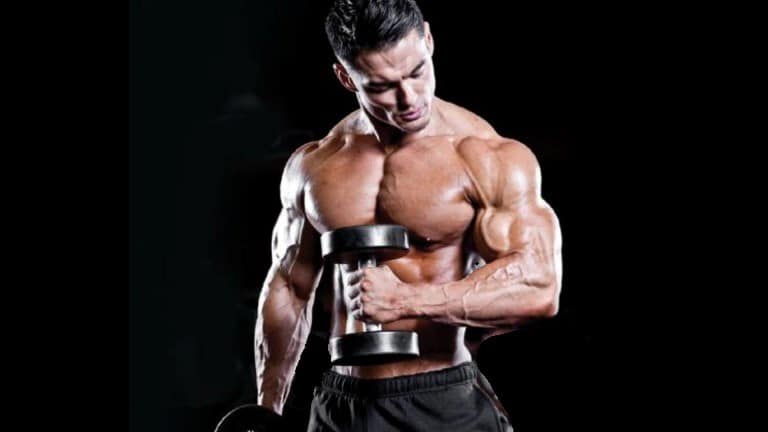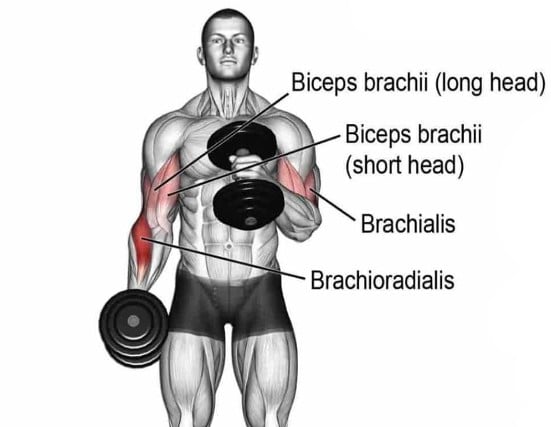The cross-body hammer curls are a powerful variation of the traditional hammer curl, specifically designed to target the brachialis, bicep and brachioradialis muscle in the forearm.
But like any exercise, mastering the cross-body hammer curl takes practice, form, and technique. That’s why we’ve created the ultimate guide to help.
In this exercise, you move the dumbbell from one side of your body to the other instead of curling it in front of you. This diagonal movement pattern is referred to as the cross-body.
For example, when curling with the right arm, you bring the weight towards your left shoulder, and vice versa.
Want to take your gains to the next level? Discover your daily calorie needs with our free TDEE calculator

- Muscle Worked During Cross-Body Hammer Curl
- Benefits Of Cross-Body Hammer Curl
- How To Do Alternating Cross-Body Hammer Curl
- Tips and Form
- Cross-Body Hammer Curl Variations
- 1. Cross-Body Cables Hammer Curl
- 2. Resistance Band Cross-Body Hammer Curl
- FAQs
- Do cross-body hammer curls target long heads?
- How do cross-body hammer curls work?
- Are cross-body hammer curls good?
Muscle Worked During Cross-Body Hammer Curl
- The cross-body dumbbell hammer curl targets the upper and lower arm muscles, most notably the brachialis and brachioradialis.
- The hammer curl involves several synergist muscles, including the biceps brachii, and forearm muscles.
- A handful of other muscles worked or play the role of stabilizer muscles, including your obliques, and rectus abdominis.

Benefits Of Cross-Body Hammer Curl
The hammer cross curl has the following advantages:
- Improved grip strength and wrist stability.
- It works the brachialis and brachioradialis, as well as the biceps and other forearm muscles.
- A neutral grip may take pressure off the wrists and elbows.
- Put minimal stress on the wrists, making them a joint-friendly option
- Places the primary stress on the long (outer) head of the biceps.
- Enhanced muscle balance and symmetry in the arms.
- This will help you challenge your muscles and prevent workout plateaus.

How To Do Alternating Cross-Body Hammer Curl
- Stand upright with your feet shoulder-width apart for stability. Put a slight bend in your knees.
- Hold a dumbbell in each hand with a neutral grip, palms facing each other.
- Your hands should be down at your side with your palms facing in.
- Keep your elbows close to your body throughout the exercise.
- As you exhale, curl the dumbbell of your right arm up towards your left shoulder.
- Continue curling until your hands are close to your opposite shoulder.
- Squeeze your biceps at the top of the movement briefly.
- Slowly lower the weights to the starting position. Switch arms and perform a rep with the other arm.
- Continue alternating in this fashion until the recommended repetitions.
- Do 8–10 reps per arm and 3–4 sets.
Tips and Form
When performing cross-body hammer curls, it’s important to avoid the following common mistakes:
- Avoid swinging weights up and down, as this will not effectively train the biceps. Focus on doing things slowly and carefully throughout the whole range of motion.
- Keep your elbows close to your body to ensure maximum muscle activation.
- To maximize muscle growth, perform exercises through their full range of motion. This means fully extending and contracting the targeted muscles in each repetition.
- It is important to choose a weight that will allow you to maintain proper form and control. Heavyweights can compromise your form and increase the risk of injury.
- Keep your wrists straight as you curl the weights and maintain a controlled and steady motion.
- Focus on the muscles you’re working on, such as the brachialis and brachioradialis. Strong mind-muscle connections help optimize muscle activation.
- Use supersets or drop sets to increase the intensity of the exercise.
- Incorporate different variations of cable hammer curls to challenge your muscles in new ways.
- Focus on slowing down the eccentric phase of the movement to increase time under tension.
- Remember to listen to your body, change the weight and intensity of the exercise if needed, and include different arm exercises in your routine to get the best results.
Cross-Body Hammer Curl Variations
There are several variations of the cross-body hammer curl that you can incorporate into your workout routine to keep things interesting and challenging.
1. Cross-Body Cables Hammer Curl
Instead of using dumbbells, you can use cable machines to perform cross-body hammer curls.
With cables, you experience consistent muscle engagement throughout the entire lift. This is because the cable machine provides resistance throughout the range of motion, unlike dumbbells, where tension can decrease at the top of the movement when the weight is lighter.
This constant tension can lead to greater activation and potential growth of the targeted muscles.
2. Resistance Band Cross-Body Hammer Curl
This variation is great for home workouts or when you don’t have access to dumbbells or cable machines.
Resistance bands offer a wide variety of exercises beyond just curls. You can target multiple muscle groups and create a full-body workout with just a few bands.
FAQs
Do cross-body hammer curls target long heads?
Yes, cross-body hammer curls target the long head of the biceps. This exercise uses a diagonal motion and a neutral grip to make the long part of the biceps work harder, which helps it grow bigger and stronger.
How do cross-body hammer curls work?
Cross-body hammer curls mainly work the brachialis, brachioradialis, and biceps brachii muscles. However, they hit the biceps’ long head harder than standard hammer curls.
Are cross-body hammer curls good?
Yes, Cross-Body Hammer Curls are a beneficial exercise for building arm strength. They target the biceps, brachialis, and brachioradialis muscles and can also enhance grip strength.

Manish is a NASM-certified fitness and nutrition coach with over 10 years of experience in weight lifting and fat loss fitness coaching. He specializes in gym-based training and has a lot of knowledge about exercise, lifting technique, biomechanics, and more.
Through “Fit Life Regime,” he generously shares the insights he’s gained over a decade in the field. His goal is to equip others with the knowledge to start their own fitness journey.
